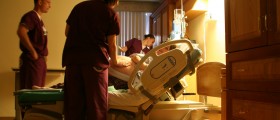
Down syndrome is a genetic condition triggered by an extra chromosome 21. Due to this fact, this condition manifests through both mental and physical disabilities. Down syndrome, being a variant of a condition called trisomy, is known to affect about one in 1,000 newborns in the UK, thereby affecting about 750 babies each year. This gives this syndrome a title of the most common health problem of this type.
Types of Down Syndrome
An average of 94% of people suffering from Down syndrome have the extra chromosome on each and every one of their cells. Next, in about 4% of cases, the extra chromosome material is attached to another chromosome and the parents carry it, without even being aware of it or showing any symptoms of the condition. This occurrence is named translocation. Finally, about 2% of all people with Down syndrome suffer from mosaic down syndrome where only some of the cells contain the extra chromosome 21. Subsequently, this is a less serious condition than regular trisomy.
Signs of Down Syndrome
Physically, people with this condition tend to appear different. They usually have eyes which slant upwards and a flat face, along with a flattened nose. Their ears are smaller, the back of their head is flat and their tongue is protruding.
Moreover, these patients are shorter than average and their palms are marked by a specific crease. In general, their limbs are shorter than normal and many of them may experience digestive problems and thyroid complications. Additionally, depending on the severity of their condition, Down syndrome may include cataracts, hearing difficulties, visual impairment and proneness to infections, Alzheimer's or leukemia.
Treatment and Additional Facts
This condition cannot be treated completely, but people with Down syndrome can live up to 60 years. Some of them may be perfectly capable of looking after themselves while others may need to be hospitalized or monitored at all times.
However, the possibility of Down syndrome can be found in a fetus, through proper tests and screenings. For example the NHS Anomaly Screening Programme is a set of tests capable of assessing and diagnosing this condition, allowing doctors and parents to find out about the risk of their baby developing this syndrome. This test can be combined with a special type of ultrasound and blood testing. Since babies with Down syndrome tend to have more fluid present between the spine and the nape, the ultrasound reveal this if present.
Finally, these tests are not necessary and are purely optional. Yet, if a woman does the test and the results are positive, she can choose to either terminate the pregnancy or give birth to the baby.

















Your thoughts on this
Loading...